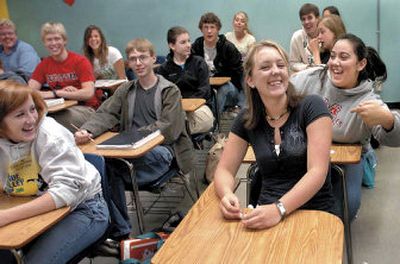More students learning Spanish

MEDFORD, Ore. – North Medford High School valedictorian Samantha Heim has aspirations of becoming a structural or mechanical engineer.
But when she graduates from Oregon State University, she plans to have two bachelor’s degrees: one in engineering and one in Spanish.
“Spanish helps you get a job, and it’s useful in everyday life,” Heim said.
“If I were to work in the field as an engineer, it would help me communicate to workers what needs to be done.”
High school students, many of whom already have studied Spanish for four or more years in public schools, are increasingly seeing the value in learning the language for their future careers, said Arnold Bleicher, Heim’s Spanish teacher at North Medford High School.
Two years of a foreign language are often required to get into a university.
“To get into a really good school you need at least three to four years of a foreign language,” Bleicher said.
“It’s a global market, and we have to be providing those language skills, and kids realize that.”
This year, at least eight out of about 50 high school valedictorians in Jackson County plan to seek a minor or major in Spanish in college.
Still others hope to travel to a Spanish-speaking country or already speak Spanish.
The number of college students seeking degrees in Spanish has inched up every year even as the demand increases in the global economy for Middle Eastern and Pacific Rim languages.
Twenty-two out of the 25 pupils in Bleicher’s fourth-and-fifth-year Spanish class plan to seek a minor or major in Spanish in college.
While Spanish accounts for less than 2 percent of all bachelor’s degrees granted in the Oregon University System, which includes Southern Oregon University in Ashland, the number of degrees in the language has doubled in the past 10 years from 115 in 1995 to 229 in 2005.
Enrollment in Spanish courses at the three campuses in the Rogue Community College system has climbed by 125 percent, from 167 to 376 students, in the last 10 years.
The trend follows the growth of the Hispanic population in Oregon and across the nation.
The number of people of Hispanic origin in the United States is projected to increase from 42.7 million, or 14 percent of the population, to 73.1 million, or 20 percent of the population, by 2030, according to the U.S. Census Bureau.
Government agencies, social services and businesses in the state, such as banks and retailers, are relying more heavily on bilingual employees to communicate with a growing number of Spanish-speaking clients, customers and employees.
More than half of the pupils in Bleicher’s fourth-and-fifth-year class at North Medford said they have used Spanish outside the classroom.
Rachel Rodriguez, a senior in Bleicher’s class who plans to be a nanny for three months in Spain before going to college, works at a grocery store and clothing shop in Medford, where she is called on frequently by her employers to serve Spanish-speaking customers.
School officials also are finding their staff needs to be savvy in Spanish to keep parents and students adequately informed.
Rogue Community College will begin offering free Spanish courses to its staff this summer in order to better serve its increasing number of Hispanic students with limited English skills.
Public school officials say English as a Second Language teachers are always in high demand, a niche Shauna Spano, a senior at North Medford, hopes to help fill in the future.
Spano plans to earn bachelor’s degrees in Spanish and education at Linfield College in McMinnville, then work as an ESL teacher for a couple of years in Central or South America.